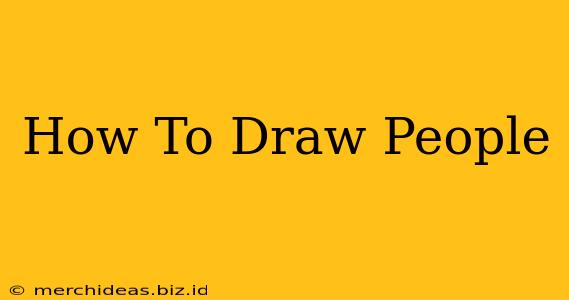So you want to learn how to draw people? It's a challenging but incredibly rewarding pursuit! Drawing the human form accurately and expressively takes time and practice, but with the right approach and consistent effort, you can significantly improve your skills. This guide will break down the process into manageable steps, perfect for beginners.
Understanding Basic Proportions: The Foundation of Figure Drawing
Before diving into complex details, grasp the fundamental proportions of the human body. While variations exist, understanding average proportions provides a solid starting point.
The Head as a Unit of Measurement:
A common method is to use the head as a unit of measurement. An average adult's body is roughly seven to eight heads tall. This helps you establish the overall height and relative size of different body parts.
- Head: The head is your starting point, always.
- Torso: Roughly three to four heads tall.
- Legs: Approximately four heads tall.
- Arms: Roughly three heads tall.
Remember, these are guidelines; individual proportions vary significantly.
Simplifying the Form: Basic Shapes and Construction
Don't get bogged down in details at first. Begin by sketching the figure using simple geometric shapes:
- Head: Oval or circle.
- Torso: Cylinder or slightly elongated rectangle.
- Limbs: Cylinders or elongated ovals.
This helps to establish the overall pose and proportions before adding more intricate details. Think of it like building a skeleton for your drawing.
The Importance of Gesture Drawing:
Gesture drawing focuses on capturing the overall movement and energy of the pose. Quick sketches (30 seconds to a few minutes) emphasizing flow and dynamic lines are crucial. This helps you understand the underlying structure and weight distribution of the figure before refining the details.
Adding Details: Refining the Anatomy
Once you've established the basic shapes and pose, you can start adding details:
- Muscles and Bones: Study basic human anatomy. You don't need to be an expert, but understanding the underlying structure will greatly enhance your ability to draw realistic figures. Observe how muscles bulge and recede depending on the pose.
- Facial Features: Eyes, nose, mouth, and ears. Practice drawing these features individually before integrating them into a complete portrait.
- Hands and Feet: These are often challenging areas. Break them down into simpler shapes (bones, joints) before adding details.
Mastering Perspective and Light and Shadow:
To make your drawings look more three-dimensional, understand:
- Perspective: How objects appear smaller as they recede into the background.
- Light and Shadow: Use shading to create the illusion of volume and depth. Observe where light hits the figure and how it casts shadows. This adds realism and makes your drawings come alive.
Practice Makes Perfect: Continuous Learning
The key to improving your figure drawing is consistent practice. Draw from life as much as possible. Use reference photos, but don't just copy; try to understand the underlying anatomy and structure. Experiment with different poses, styles, and mediums.
Resources for Learning:
Numerous online resources, books, and courses can aid your journey. Explore anatomy books, online tutorials, and figure drawing workshops to enhance your understanding.
Remember: Don't be discouraged by initial challenges. Drawing people takes time and dedication. Embrace the learning process, celebrate your progress, and enjoy the journey of mastering this rewarding skill.
